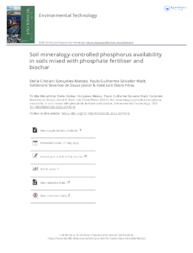Soil mineralogy-controlled phosphorus availability in soils mixed with phosphate fertiliser and biochar.
Soil mineralogy-controlled phosphorus availability in soils mixed with phosphate fertiliser and biochar.
Author(s): MATOSO, S. C. G.; WADT, P. G. S.; SOUZA JÚNIOR, V. S. de; PÉREZ, X. L. O.
Summary: he biochar amendment to soil proved to be beneficial to improve soil quality and provide nutrients. However, the effect of biochar on the availability of P is still controversial. We aim to study the effect of adding phosphate fertiliser and biochar on the P bioavailability in soils of different mineralogies. Eight biochars derived from biomass (rice husk and coffee husk), soil (sandy and clayey), and phosphate fertiliser (triple superphosphate) were produced. The biochar enrichment process with superphosphate was carried out before and after pyrolysis. Thus, we tested two biochar groups: (1) enriched biochars prior to pyrolysis; (2) enriched biochars after pyrolysis. These biochars were tested as P sources in soils of three mineralogies (kaolinite/oxide, kaolinite, and smectite). Batch sorption-desorption experiments were conducted. The sorbed P was fractionated to examine the factors controlling the retention of applied P. In the three soil mineralogies the use of enriched biochars prior to pyrolysis results in lower availability of P. In contrast, the enriched biochars after pyrolysis increase the bioavailability of P. The coffee husk biochar is more suitable than rice husk biochar to protect P from soil retention reactions. The use of sandy soil rather than clayey soil in enriched biochars compositions results in higher P content availability when applied to soils. The factor that controls the retention of P is the reaction between P, organic compounds, and Fe and Al compounds. The greater the relationship between biochar and soluble P in the fertiliser, the higher the increase of P retention.
Publication year: 2023
Types of publication: Journal article
Unit: Embrapa Rondônia
Observation
Some of Embrapa's publications are published as ePub files. To read them, use or download one of the following free software options to your computer or mobile device. Android: Google Play Books; IOS: iBooks; Windows and Linux: Calibre.
Access other publications
Access the Agricultural Research Database (BDPA) to consult Embrapa's full library collection and records.
Visit Embrapa Bookstore to purchase books and other publications sold by Embrapa.

